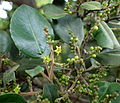| Rhamnus glandulosa | |
|---|---|
 | |
| Scientific classification | |
| Kingdom: | Plantae |
| Clade: | Tracheophytes |
| Clade: | Angiosperms |
| Clade: | Eudicots |
| Clade: | Rosids |
| Order: | Rosales |
| Family: | Rhamnaceae |
| Genus: | Rhamnus |
| Species: | R. glandulosa |
| Binomial name | |
| Rhamnus glandulosa | |
| Synonyms [2] | |
| |
Rhamnus glandulosa is a species of plant in the family Rhamnaceae. [3] It is endemic to Madeira and the Canary Islands. [4]


